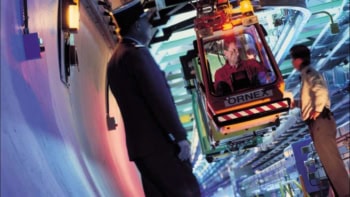Lists of outstanding scientific challenges have been all the rage at the turn of the new millennium – but they all assume that society will pay for them to be solved, whatever the cost. Robert P Crease lists 10 issues facing science and society that must first be addressed

One hundred years ago the mathematician David Hilbert compiled a list of his field’s great unsolved problems. A century later, drawing up such lists has again become popular – even Physics World carried out a millennium survey last year and published articles on the ten “outstanding challenges” in physics (December 1999). Meanwhile a group of theoretical physicists drew up a list of ten millennium questions that included the lifetime of the proton, the cosmological constant and the supersymmetric nature of the universe (see feynman.physics.lsa.umich.edu/strings2000/millennium.html). Answering any one of these challenges would require a huge project that would consume enormous amounts of resources. The authors of these and other lists cheerfully seem to assume that society eventually will. I’m not so sure.
A recent article by Roel Snieder in Nature (2000 406 939) compared scientific communities to the colonies of tube worms that live on the ocean floor and clustered around hydrothermal vents that supply them with nutrients. Like the tube worms, the author wrote, scientists “are completely reliant on the stability of their habitat”. However, as scientific projects have grown in scale, expense and visibility, they can sometimes overtax, or are perceived as environmental threats to, their habitats. Key scientific facilities, including the Advanced Neutron Source and the Superconducting Super Collider in the US, have been cancelled in the planning or construction stages in recent years.
Such habitat disruptions are usually blamed on villains such as schools, the media and politicians. However, the behaviour of these players merely reflects deeper habitat fluctuations. Not only are the fluctuations likely to continue, but they are also likely to grow worse as demands on the habitats increase. Are scientific projects poised to run up against a natural limit, or is some co-evolution or reintegration of projects and habitats possible?
Millennium questions: science and society
I propose another millennium list: ten questions that must be answered for such co-evolution to be possible. The bigger and more expensive scientific projects grow, the more they will tax the habitat, the more its stability matters and the more important these questions become.
1. How is trust generated, perpetuated, disrupted and recovered?
Trust is of increasing importance in contemporary science. Rarely a concern for university-based scientific projects before the Second World War, trust is now critical in planning any large-scale scientific undertaking and is an ongoing concern for any scientific institution. Several episodes in the past 50 years have generated public distrust in connection with scientific research, including the infamous Tuskegee study of the course of untreated syphilis in African-American males, as well as cover-ups of toxic chemical and radiation spills. This distrust has then adversely affected socially valuable and morally justifiable research.
2. How can we avoid building environmental Maginot lines?
Environmental risks often come to political attention only in response to specific real or manufactured crises. This piecemeal approach can result in significant resources being targeted for minor or even non-existent environmental hazards (such as background-level radiation and electromagnetic fields). It can end up building, as it were, a series of environmental Maginot lines. This is harmful because it squanders resources on the wrong places, lulls people into a false sense of security, is vulnerable to political manipulation and contributes negligibly to the wider social purpose – public safety – that is the ostensible goal. A society that addresses risk this way endangers not only science but also itself.
3. How can reliance on expertise be reconciled with democratic pluralism?
Expertise is crucial for a society that depends on science and technology. However, the authority conferred on an expert seems to collide with the democratic, anti-elitist urge to accord equality to all opinions. How can the need for expertise in a society dependent on science and technology be reconciled with democratic pluralism?
4. How can science be presented in the media?
The media is like a prism, systematically distorting what passes through it while giving the illusion of transparency. Its behaviour, although not immutable, is so deeply ingrained and reinforced by other factors that it would be as pointless to blame the media or look for it to change as it would be to curse a prism for its distortions or to hope for alterations in the laws of optics. What other possibilities are there for presenting science in the media?
5. How is science social?
Science is both interest-driven – in other words, developed in response to changing human social needs and desires – and event-driven, that is, developed in response to physical events in the laboratory. The recent “science wars” between scientists and certain sociologists of science have been fought by those who emphasize only one aspect or the other. Why not both aspects at once? The concept of performance provides a clue: a performance is both a singular act that is produced by a specific social and historical context, and simultaneously something that can produce a meaning that is not confined to that context. What would a performative conception of science look like?
6. Can discourse be defeudalized?
In public controversies with a technical dimension, positions are often not argued but dramatically presented by people who think in slogans and communicate in images. Anti-biotechnology protesters who dress up as Frankenstein monsters or protesters who call shipments of low-level radioactive wastes “mobile Chernobyls”, while carrying placards of the skull-and-crossbones, displace, in public arenas, those who would argue or inform. The issues are treated as if they were entertainment, and the public is effectively precluded from engaging them. The German philosopher Jurgen Habermas refers to such patronizing tactics as a “refeudalization” of the public sphere. Is there an alternative to capitulating to such feudalization? Can one try to steer discourse towards mutual understanding and still get a hearing?
7. How can a better “impedance matching” be achieved?
A vast distance exists between the knowledge about a subject that circulates in a laboratory and the knowledge about the same subject among the public. A huge gap exists between the “load”, as it were, born by the discourse in the two cases. Connecting the two requires a kind of “impedance matching”, in which the load is stepped down. This cannot be a one- or two-step process – education plus science popularization, say – but requires an entire spectrum of processes bearing different loads.
8. Can science and pseudoscience coexist?
Pseudoscience is a symptom of magical thinking, which is in turn not a corrupt or defective form of scientific thinking but thinking of a different kind. Magical thinking plays a different function in human life, which poses and seeks answers to a different set of questions than scientific thinking. Can science peacefully coexist with it?
9. Is science a special interest?
Robert Oppenheimer once called science a “special interest”, in the sense that everyone benefits when it flourishes. Nowadays it is often viewed as a special interest in a more current sense, as the doings of an entitled elite with special privileges. Which is it?
10. How to respect the public sphere?
It is tempting to treat the public as a poorly educated and easily manipulated mass of people who must be convinced or even conned into supporting large scientific projects. If that were true, the safest way to ensure high-quality science would be to insulate it as much as possible from the public sphere. However, the public is not a static mass; it, too, is actively engaged in sense-making and as interested in predictive stability. As the philosopher John Dewey pointed out, the public sphere is always in the process of being generated or reconstructed. How might the public sphere be reconstructed differently?
The critical point
My millennium list is different from others. The lists compiled by scientists consist of technical questions that can be solved independently of each another, while my questions cannot be technicalized. Mine is a list of social problems, each of which is, in effect, a version of the same one, namely: how does the public sphere work? Each problem addresses a different aspect of the way in which science is positioned, and positions itself, in the public sphere.
These problems cannot therefore be attacked piecemeal – by a set of taskforces on, say, trust, the expert-lay divide, communicating to the public and science education. Nor can they be addressed by scientists alone, any more than tube worms have it in their power or ability to affect the character of the hydrothermal vents that they depend on. It may require some Sputnik-like event – perhaps a huge international scientific project the collapse of which threatens the very public that failed to support it – to provoke the soul-searching, perception of imminent threat, massive reorganization and interdisciplinary commitment needed to address them. Or the reintegration may never occur. But failing to take these questions seriously means failing to be serious about the future of science.
The integration of science and its habitat wasn’t always like this. Pre-19th-century “natural philosophy” had a lively and diverse exchange with a broad spectrum of social groups. However, since then the interaction between science and various segments of the public has grown more one-dimensional. Perhaps the relative stability of the habitat in its support of large scientific projects in the second half of the 20th century was a historical fluke, due to unprecedented prosperity coupled with the authority that scientists gained during the Second World War, and that only a new reintegration will support ever-larger projects.
If such a co-evolution is possible, these questions will have to be answered. If they are not resolved, many of the other, purely scientific, millennial questions will remain unsolved – guaranteed.



